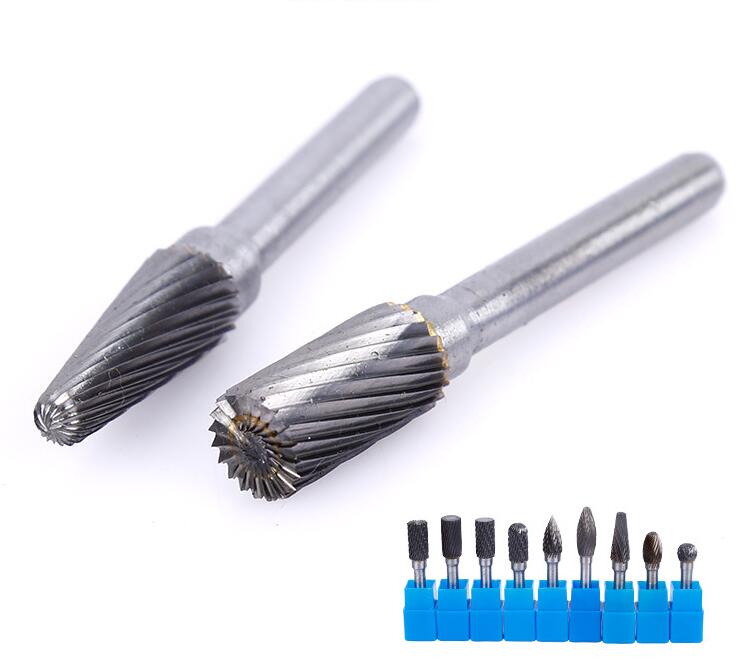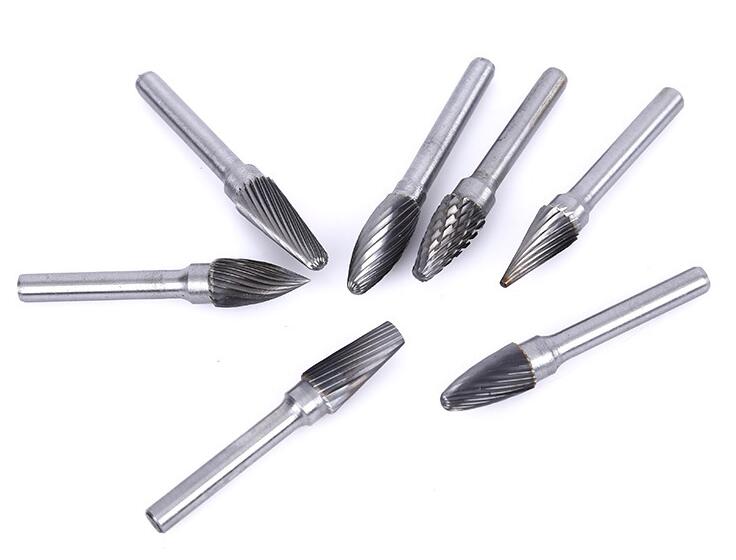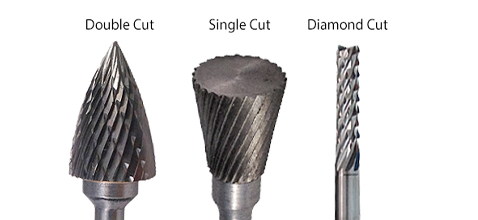|
7 Facts About Tungsten Carbide Burrs and How To Use Them
Carbide Rotary Burrs are used for cutting, shaping, grinding and for the removal of sharp edges, burrs and excess material (deburring) and this is what we talk about in the following article. For drilling holes or cutting a hole in metal then a carbide drill or a carbide end mill, carbide slot drill or a carbide router is required rather than a carbide burr. For carving into stone you would ideally use a Diamond Burr. 1. Carbide Burrs Can be Used on Many MaterialsTungsten Carbide burrs can be used on many materials: metals including steel, aluminum and cast iron, all types of wood, acrylics, fibreglass and plastics. When used on soft metals such as gold, platinum and silver, carbide burrs are ideal as they will last a long time with no chipping or breaking.
Different cuts of carbide burrs will be best suited to certain materials, see the next point below to find out about the different cuts. What Do You Use Carbide Burrs In?Ideally carbide burrs are used in Air Tools i.e Die Grinders, Pneumatic rotary tools and high speed engravers. Micro Motors, Pendant Drills, Flexible Shafts, and hobby rotary tools such as a Dremel. Always use a handpiece that runs true i.e with no wobble. Who Uses Carbide Burrs?Carbide burrs are widely used for metalwork, tool making, engineering, model engineering, wood carving, jewellery making, welding, chamferring, casting, deburring, grinding, cylinder head porting and sculpting. And are used in the aerospace, automotive, dental, metal sculpting, and metal smith industries to name but a few. 2. Carbide Burrs Commonly Come in Two Cuts; Single Cut and Double Cut (Diamond Cut)Single cut (one flute) carbide burrs have a right handed (Up cut) spiral flute. These tend to be used with stainless steel, hardened steel, copper, cast iron, and ferrous metals and will remove material quickly with a smooth finish. Use for heavy stock removal, milling, deburring and cleaning.
Double cut carbide burrs tend to be used on ferrous and non ferrous metals, aluminium, soft steel and also for all non-metal materials such as plastics and wood. They have more cutting edges and will remove material faster. Double cut are sometimes referrred to as Diamond Cut or Cross Cut (2 flutes cut across each other) will leave a smoother finish than single cut due to producing smaller chips as they cut away the material. Use for medium-light stock removal, deburring, finishing and cleaning. A double cut carbide burr is the most popular cut and will see you through most applications.
The below image indicates the double cut, single cut and again, the double cut or diamond cut.
Shank sizes of your carbide burrs:The shank is the mount of your burr that fits into your rotary tool, die grinder, micro motor etc; so the opposite end to the working part of the tool. These are usually found in the following shank sizes:
3. The Various Shapes of Carbide Burrs and How To Use ThemMaking a decision on what shape to use will depend on the profile or cut you are looking to achieve. These different shaped burs will get into many a nook and cranny and produce some interesting profiles. Carbide Ball BurrsUse a ball or spherical shaped carbide burr to create concave cuts in your material or to shape and hollow out an area. Small carbide ball burrs from as tiny as 0.5mm in diameter are ideal for intricate carving projects. Many wood carvers, stone carvers and metal engravers use these carbide carving burrs in a hobby drill, micro motor or a high speed handpiece. As we mentioned before, make sure to use a handpiece that runs true i.e with no wobble. Carbide Tree Burrs
Use for rounding off edges and making concave cuts. Use the pointed end for cutting in hard to reach areas and acute angled contours. Carbide Inverted Cone Burrs
Use inverted cone shaped tungsten carbide burrs for making v-cuts and rear side chamfering. Carbide Pointed Cone & Carbide Round Nose or Ball Nose Burrs
Good for rounded edges and surface finishing in difficult to reach areas or tight and narrow angles and contours. The round nose or ball nose cone are often referred to as a taper shape. Cylinder Burrs. Round Nose/Ball nose/End Cut
Choose from an end cut cylinder (with a cutting edge on the end) for contour finishing. Cylinder without end cut (flat on the end and no cutting edge) for contour finishing and right angled corners or a round nose or ball nose shape which is a cylinder shaped carbide burr but with a rounded head. Oval Burrs
Flame Burrs
Oblate SpheroidA wheel shaped burr with a smooth top and fluted sides. Great for channel work and shaping. Countersink BurrsChoose from 60 degree or 90 degree angle countersink burs, sometimes referred to carbide cone burrs. These are ideal for beveling, counterboring, chamfering and for getting into acute angled areas of your work. If you're not sure what shape burryou want, or you would like a variety, why not try a set of 10 with different shapes in. 4. What Speed or RPM should you use your Carbide Burrs?The speed at which you use your carbide bur in your rotary tool will depend on the material you're using it on and the contour being produced but it's safe to say you do not need to exceed speeds of 35,000 RPM. The table below shows some approximate speeds. If the burs are chipping easily this could be due to the speed being too slow. However, it's ideal to start the bur off slow, increasing the speed as you go along. High speeds will prevent clogging in the flutes of your burs.
5. Do Not Apply Too Much PressureAs with all drill bits and burrs, let the burr do the work and apply only a little pressure otherwise the cutting edges of the flutes will chip away or become smooth too quickly, reducing the life of your burr. 6. Carbide Burrs are Harder Than HSS BurrsOur Carbide Burrs are machine ground from a specially chosen grade of carbide. Due to the extreme hardness of the Tungsten Carbide they can be used on much more demanding jobs than HSS (High Speed Steel). Carbide Burrs also perform better at higher temperatures than HSS so you can run them hotter, and for longer. HSS burrs will start to soften at higher temperatures so carbide is always a better choice for long term performance. What Are The Advantages of Tungsten Carbide Burrs?
7. Keep The Carbide Burr On The MoveWhen using your carbide burr try not to keep it still for too long as this will prevent the burr from digging and jabbing into your material causing unsightly marks and roughness. End on an 'up' stroke for a smoother finish to your work. Helpful note: Using a carbide burr on Soft Cast iron is a great way to de-clog them. I hope you feel better informed now as to how you should use your carbide burrs, why you should use them and what you should use them on. Helpful note: Carving StoneFor carving into stone you will need to use Diamond Burrs. Stay Safe:
Buying Carbide BurrsWe have a good selection of premium quality carbide burrs available for you to purchase from our online shop. For larger quantities or unusual shapes please contact us |
Copyright 2019 All rights reserved
Zigong Jingqiang Cemented Carbide Co., Ltd. Address: No. 105 Quarrying Road, Lianggaoshan Street, Daan District, Zigong City, Sichuan Province, China
Contact person: Manager Chen tel: 13350681748
Tel: 0813-5202533
Mailbox: sales@zgjqhj.com
Zip code:643010


















